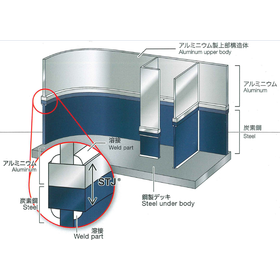Explosive Bonding Clad: Enables the Joining of Dissimilar Metals That Cannot Be Welded!
We offer structural dissimilar material joints that enable strong bonding between lightweight metals such as aluminum, magnesium, titanium, and steel materials!
Asahi Kasei Corporation has an explosive welding technology that utilizes the instantaneous high energy generated when explosives detonate to metallurgically join dissimilar metals at room temperature. This product significantly contributes to the weight reduction of vehicles, ships, molds, and more. ■ STJ(R) "Structural Transition Joint" STJ(R) is a compact and highly durable structural joint that enables the welded integration of aluminum alloy structures with carbon steel or stainless steel components. ■ Flame-retardant Magnesium Alloy Joint A structural joint made of flame-retardant magnesium alloy and aluminum alloy or stainless steel. *For more details, please refer to the PDF document or feel free to contact us.
Inquire About This Product
basic information
The shipbuilding structural dissimilar material joint STJ(R) has obtained certification from the Japan Maritime Association (NK), Lloyd's Register (LR), Det Norske Veritas (DNV), Korean Register (KR), Kyushu Transport Bureau (JG), Bureau Veritas (BV), and American Bureau of Shipping (ABS).
Price range
Delivery Time
Applications/Examples of results
Transport equipment such as vehicles like trains and cars, and vessels (LNG ships, patrol boats).
catalog(1)
Download All CatalogsCompany information
BA Clad is a clad steel plate manufactured by Asahi Kasei using the explosive cladding method, and it has received high praise in various fields since its release. The explosive cladding method utilizes the enormous energy released during an explosion to instantaneously bond metal plates together, thereby producing clad steel plates. BA Clad is used for plants and equipment in the chemical industry, petroleum refining, petrochemicals, and power generation, and is exported widely both domestically and internationally, either as flat plates or various components. It is used as corrosion-resistant and heat-resistant structural materials for power plant condenser tube sheets, heat exchanger tube sheets for chemical plants, shells, and end plates, among others, and its applications are continually expanding to include rolling mill liners, electrodes, cryogenic joints, ultra-high vacuum joints, and structural joints for ships and LNG tankers. We offer solutions related to metal joining (dissimilar metal joining, similar metal joining) and cladding. We can provide joining characteristics such as material properties, joining strength, minimization of alloying at the joining interface, and joining area, which are difficult to achieve with other joining methods, such as various welding techniques, diffusion bonding (roll bonding, HIP, etc.), friction joining (friction welding, friction stir welding (FSW)), electromagnetic pressure bonding, brazing, plating, and thermal spraying.







